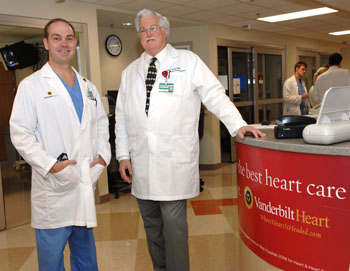
John McPherson, M.D., left, and John Selby, M.D., are teaming to lead Vanderbilt Heart and Vascular Institute’s Cardiovascular Intensive Care Unit. (photo by Neil Brake)
Dual leadership enhances Cardiovascular ICU
Working under the theory that two heads are better than one, a surgical director and a medical director are teaming up to care for Vanderbilt Heart's sickest patients on the Cardiovascular Intensive Care Unit (CVICU).
John Selby, M.D., professor of Clinical Anesthesiology and Clinical Surgery, accepted the surgical director post in July. John McPherson, M.D., assistant professor of Medicine, is the medical cardiology director.
This unique approach to dual leadership reflects the overall vision of Vanderbilt Heart & Vascular Institute (VHVI), which is collaboration between cardiologists and cardiac surgeons, two groups historically separated by professional differences of opinion.
“Typically, a cardiologist will see the patient and say 'I can treat that patient medically,' and the surgeon will look at the same patient and say, 'I can treat that patient surgically.' But they don't ask what is best for the patient,” McPherson said. “We ask that. Often it's surgery, often it's a medical approach, and many times we find it's a hybrid approach.”
In the 26-bed unit on 5 North of Vanderbilt University Hospital, arrhythmia patients, for example, occupy rooms adjacent to post-operative patients as well as those with heart failure who are candidates for, and recipients of, transplants and artificial assist devices.
The nursing staff is adept at caring for both patient populations and participates in rounds with the cardiologist, intensivist, nutritionist, pharmacist and social worker.
“At other places, cardiologists, intensivists and surgeons each round on patients individually. At Vanderbilt, we do it face to face in a coordinated effort twice a day,” Selby said. “The fact is, the more heads you get together, the better off the patient is.”
As an intensivist, Selby specializes in critical care, which involves a multi-system approach to critically ill patients. Once surgery is complete, the intensivist coordinates the treatment of problems that may relate to other organ systems affected by the patient's critical illness, including kidney function, electrolyte disturbance, nutritional needs and safety concerns.
Selby and McPherson are working together to implement two new protocols.
The therapeutic hypothermia protocol is a process of rapidly cooling the body temperature to 89.6 degrees Fahrenheit to limit the extent of brain damage following sudden cardiac arrest. It is implemented as soon as a patient arrives on the CVICU.
“It's a very complicated thing to do because it causes a lot of changes in the metabolic status of a patient. Dr. Selby automatically sees a patient like that in consultation with us,” McPherson said.
They are also ironing out details for the shock team. Cardiologists, surgeons and cardiac anesthesiologists will work together when caring for someone who comes to the hospital in cardiogenic shock, a serious condition caused by inadequate blood flow to vital organs and tissues.
In an emergent situation, the shock team works together to institute percutaneous bypass, reverse the conditions of shock and restore perfusion to the vital organs while other members of the team start working on the heart itself.
At the center of the collaborative relationship is doing what is best for the patient.
“I think we're unique. I don't think there are very many institutions out there that combine both populations on one intensive care unit or even combine both programs under the same umbrella,” said Jeannie Byrd, M.S.N., R.N., manager of the CVICU.













